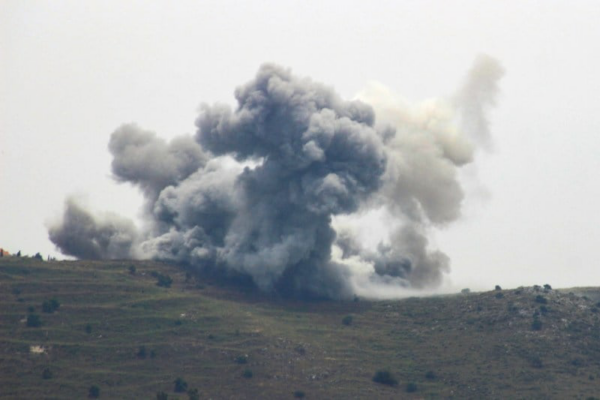By Amy Mackinnon, Jack Detsch, and Robbie Gramer
Photo: Smoke billows from the site of an Israeli airstrike on the outskirts of the southern Lebanese village of Alma el-Chaab near the Lebanon-Israel border on May 22. KAWNAT HAJU / AFP
KFAR VRADIM, Israel—Standing on a hilltop in the small town of Kfar Vradim in Israel’s western Galilee region, Sarit Zehavi, a former Israeli military intelligence analyst, gestures across the verdant valley on the horizon some nine kilometers to the north.
Just beyond the clusters of villages that dot the mountainous region—home to Jews, Arabs, Christians, and Druze—lies Israel’s northern border with Lebanon. On the other side lies one of Israel’s most powerful foes: Hezbollah, the most heavily armed non-state actor in the world. Financed, equipped, and trained by Iran, the group has a vast arsenal of rockets and missiles, including anti-ship cruise missiles and surface-to-air missiles, as well as advanced cyber-capabilities.
Since the Hamas attack on southern Israel on Oct. 7, 2023, Hamas’s ally Hezbollah has launched hundreds of mortar, missile, and rocket attacks into Israel in near-daily clashes with the Israel Defense Forces (IDF). Israel responded with nearly 4,000 strikes of its own, mostly with artillery and missiles, between October 2023 and March of this year, according to the Armed Conflict Location and Event Data Project. It is an often overlooked front that many fear still has potential to spiral into a catastrophic new war that could quickly engulf the region.
“I truly don’t know where this is heading, and your bet is as good as mine,” said Zehavi, who is now president of the Alma Research and Education Center, a think tank based in the region.
Tensions ramping up. Hezbollah’s attacks have become increasingly sophisticated in recent weeks and are reaching deeper into Israel.
Last week, the group struck two IDF surveillance balloons. One attack, which struck near Golani Junction some 21 miles south of the Lebanese border, resulted in a direct hit on the large IDF observation balloon, Sky Dew, with Soviet S-5 rockets launched from an unmanned drone, thought to be an Iranian-made Ababil T. The attack is believed to be the first time the group has succeeded in carrying out an air-to-surface strike from within Israeli airspace since Oct. 8, 2023, according to an analysis by the Alma Center, which noted that “although this is not a very advanced capability at this stage, it does constitute a significant leap forward for Hezbollah.”
A second reconnaissance balloon was struck closer to the border by an Iranian-made Almas antitank missile. While Israel has a formidable, multilayered air defense system capable of intercepting both short- and long-range missiles, it has no way of defending against attacks from precision antitank missiles, which have been used in an “unprecedented” manner by Hezbollah to target civilian and military sites along the border. “We don’t have an answer to the antitanks,” Zehavi said.
New tech on the not-quite-battlefield. Communities along Israel’s northern border with Lebanon have been battered with strikes from Russian Kornet antitank guided missiles, designed to be used against heavy battle tanks, as well as the Almas, the designs of which are based on a reverse-engineering of Israeli technology, Zehavi said.
Hezbollah’s use of the system is new, she said. “We’re familiar with the technology, but not with the fact that it’s in the hands of Hezbollah,” she said.
Approximately 60,000 people were evacuated from communities along the northern border with Lebanon in the days and weeks after the Oct. 7, 2023, attacks, and they remain scattered across the country, staying with family and in hotels and repurposed holiday resorts.
The clashes have also driven about 90,000 people in southern Lebanon from their homes, according to the International Organization for Migration. The fighting along the border has killed more than 250 Hezbollah fighters and about 75 civilians, Reuters reported earlier this month.
“Something we didn’t fathom.” Itai Peres, an evacuee from Kibbutz Dafna, located just over a kilometer away from the Lebanese border, said that before the Oct. 7, 2023, attacks, he had all but forgotten how close the border was to their town. Following the 2006 Israel-Hezbollah War (also called the Second Lebanon War), the area was relatively quiet, with Hezbollah mounting just a few dozen attacks in the 17 years since. “The general perception was that Hezbollah was deterred,” Zehavi said.
In the first days of the war, Peres, a third-generation resident of the kibbutz, was reluctant to leave with his wife and three daughters.
“We’ve been through wars, we’ve been through the Second Lebanon War, and basically we thought to ourselves, ‘If they’re going to bomb, we know what they’re sending.’ We thought we knew,” he said.
But the Hamas attacks, which saw the Gaza-based group launch an unprecedented ground incursion into Israel, brought with it the new and terrifying prospect of a similar ground invasion by Hezbollah. “What we have now that we didn’t have in the past is the threat of what we had in the south. Basically a raid,” he said. “This is something we didn’t fathom.”
FOREIGN POLICY


Leave a Reply
You must be logged in to post a comment.